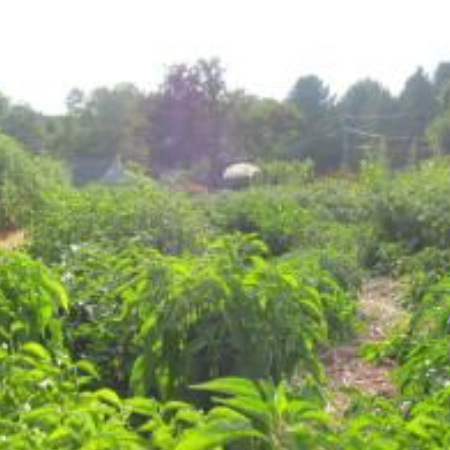
Creating a Garden Map and Choosing Seed Amounts
 Original art for New Yorker Tomato. Found map and painting by Rochelle Cohen.
Original art for New Yorker Tomato. Found map and painting by Rochelle Cohen.By sketching out your growing space before ever peeking inside a seed catalog, both aspiring and returning gardeners can assess how to best grow on whatever land available to them. A garden map can, of course, be a precise blue-print, but we prefer to make them like gardens themselves: slightly wild and freeform. A garden map can be a great organizational aid, an exercise in asking important questions and assessing resources. With these goals in mind, try starting with the big picture and working your way down to the details:
Sketch out your whole garden area: Including not just the growing area, but other major elements like a water spigot, greenhouse, compost pile, shed, access road.
Shade in or label your growing space. Unless you are growing for commercial production, there’s no reason to limit yourself to rectangles. Are there nooks particularly suitable for certain crops or garden elements? Isolate the growing areas by shading them in lightly or labeling.
Identify the limitations. Mark areas on the map that don’t receive full sun (for example, the bed adjacent to the shed), fences, roads, spots where water hoses won’t reach, where the soil is notoriously deficient, or where kids and pets play.
 Turn limits into crop-plan decisions. Each space has its particularities and each particularity has a plant that loves it. Work with the limitations of your growing space by pairing them with varieties appropriate for that space. A fence, for example, can double as a great trellis for climbing peas, beans, cucumbers, and flowers. A semi-shaded section can act as a welcome relief to cool-weather-loving crops like lettuces and Brassicas in the heat of summer. An area with heavy foot-traffic can be make a good home for a tough (and delicious!), perennial groundcover like Thyme. A section in the back where irrigation doesn’t reach might be the perfect environment for a wildflower meadow: a sanctuary for beneficial insects and birds.
Turn limits into crop-plan decisions. Each space has its particularities and each particularity has a plant that loves it. Work with the limitations of your growing space by pairing them with varieties appropriate for that space. A fence, for example, can double as a great trellis for climbing peas, beans, cucumbers, and flowers. A semi-shaded section can act as a welcome relief to cool-weather-loving crops like lettuces and Brassicas in the heat of summer. An area with heavy foot-traffic can be make a good home for a tough (and delicious!), perennial groundcover like Thyme. A section in the back where irrigation doesn’t reach might be the perfect environment for a wildflower meadow: a sanctuary for beneficial insects and birds.
Choose a layout. After familiarizing yourself with your soil (is it sticky or sandy? does it needed organic matter? amendments? does it drain quickly or slowly?), decide how you want to organize your crops. The main decision is whether to grow directly in the ground or to make raised beds. Growing in rows directly in the ground is an easier option for large spaces. For more contained gardens – a 20’x20’ area, for example -- raised beds allow for better drainage; easier access sowing, harvesting, and weeding; and no need to leave empty spaces within a bed for paths. If growing in rows, save 18 inches for pathways. If growing in raised beds, make them as wide as your arm can reach from either side of the bed (four feet wide is common). Raised beds lend themselves well to Square Foot Gardening – an intensive crop rotation system that lets a gardener get the most production out of a small space. To learn more about Square Foot Gardening, take a look at Erin’s article on this topic.
In choosing a layout and garden size, also consider back-bending hours. Row-plantings open up possibilities for tools such as wheeled cultivators, seeders, and hoes, or mechanized tillers, while hand-tools work best in raised beds.
Choose your crops and amounts. After you’ve collected information about your space and decided on a garden layout comes time to choose crops. Pick spaces for perennials first, as annuals will get moved around these more-permanent plantings every season. Then, consider plant height, shape, and growing habits. Taller varieties, for example, should be go on the north side of a bed, so as not to shade out their shorter neighbors. Cucurbits such as melons, cucumbers, and squash, will need a lot of space to spread out along the ground. Most seed suppliers include information about how much space each plant occupies within a row and how much space it requires between rows. Based on that and the size of your bed, you can calculate how many of each crop can fit in a given area.
 Lastly, plan to sow. After your garden map is filled in and seeds are ordered, it's is time to make a seed-starting calendar. Some crops, such as onions, will need to be sown next month, others, like corn and beans, won't be grown till as late as Mother's Day. For your garden map to be a continual resource throughout the season, it's important to stick to a sowing schedule. Learn how craft you own seed starting calendar from our Seed Starting 101 Series.
Lastly, plan to sow. After your garden map is filled in and seeds are ordered, it's is time to make a seed-starting calendar. Some crops, such as onions, will need to be sown next month, others, like corn and beans, won't be grown till as late as Mother's Day. For your garden map to be a continual resource throughout the season, it's important to stick to a sowing schedule. Learn how craft you own seed starting calendar from our Seed Starting 101 Series.






